
About Skin Diseases
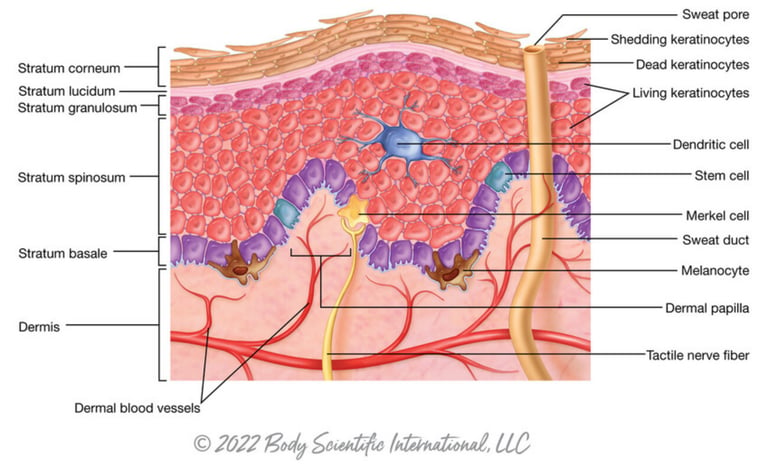

The skin is the largest organ of the human body, playing multiple crucial roles. It acts like a versatile fortress, protecting and sustaining our lives.
Primary Functions of the Skin
Physical Protective Barrier
Temperature Regulation
Sensory Function
This is the skin's most fundamental and vital function. It can resist external physical damage (like friction and impact) and prevent pathogens such as bacteria, viruses, and fungi from entering the body. Additionally, the stratum corneum effectively prevents excessive water loss from the body, maintaining fluid balance.
The skin is the body's "thermostat." When the body gets too hot, the skin helps dissipate heat through sweating. At the same time, blood vessels in the dermis dilate to increase blood flow, aiding in heat release. When the body is cold, these vessels constrict to reduce blood flow and retain body heat.
The skin is full of nerve endings and sensory receptors, allowing us to perceive the outside world. It can distinguish between touch, pressure, pain, cold, and heat, which are crucial for our survival and help us avoid danger.
Synthetic Function
Under ultraviolet B (UVB) radiation from sunlight, the skin can synthesize Vitamin D. This vitamin is essential for bone health because it helps the body absorb calcium.
The skin helps the body excrete small amounts of metabolic waste, such as urea and excess salt, through sweat glands.
Excretory Function
The skin contains immune cells like Langerhans cells, which act as the first line of defence for the immune system. When harmful substances attempt to invade, these cells can quickly identify them and activate an immune response, helping the body fight off infection.
Immune Function
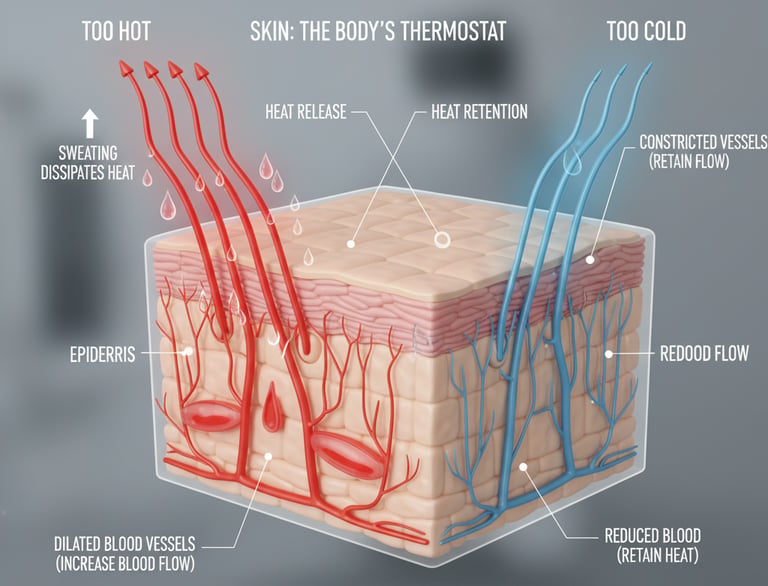

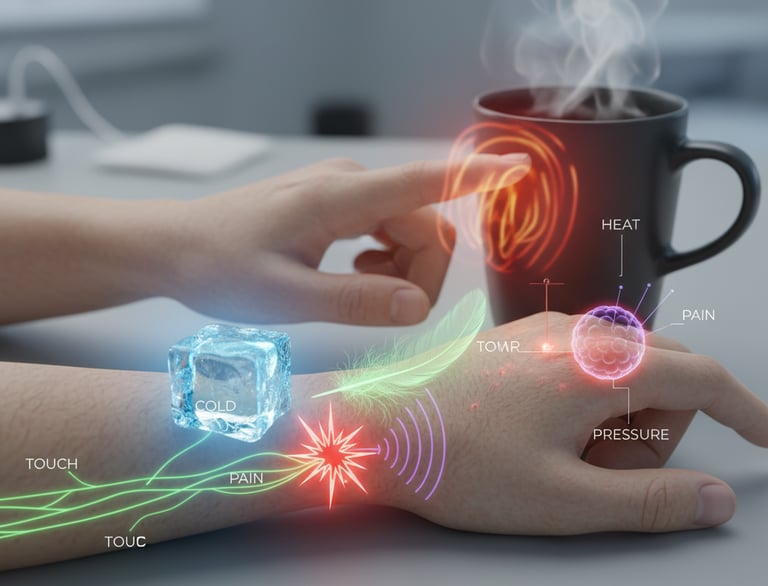

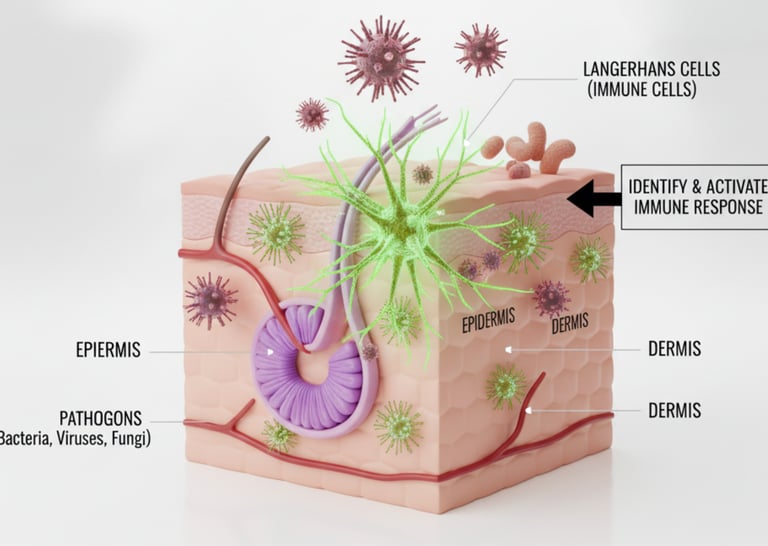

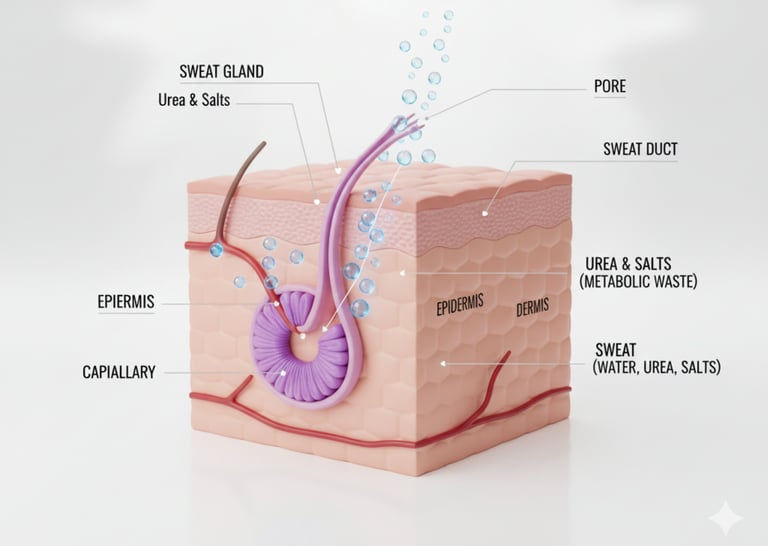

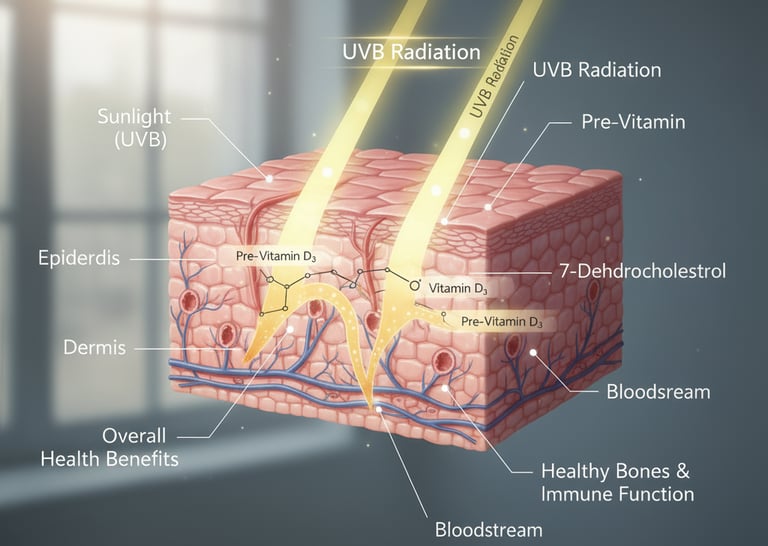

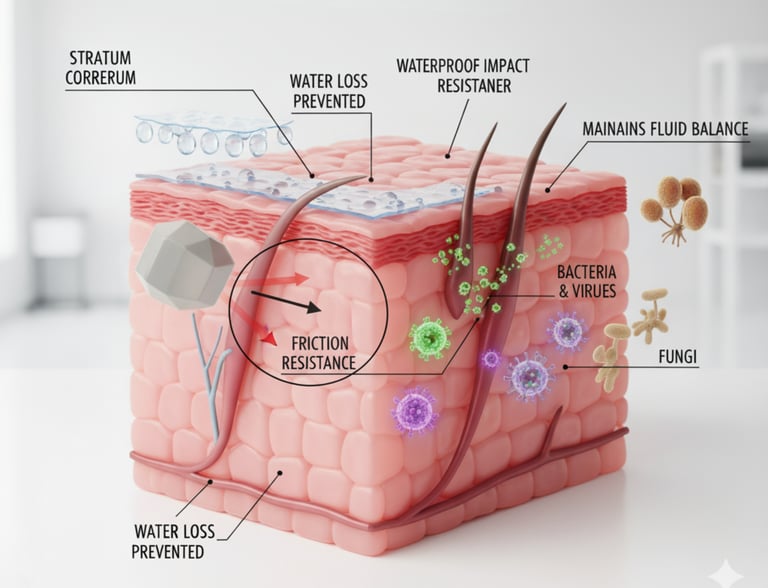

Common Skin Diseases
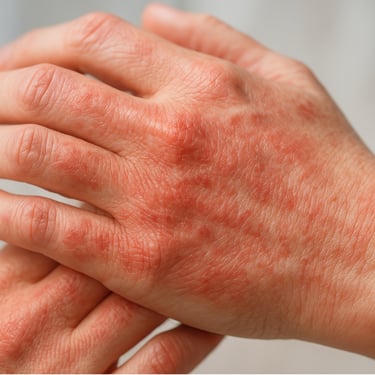
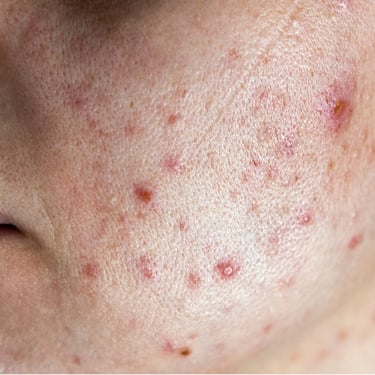
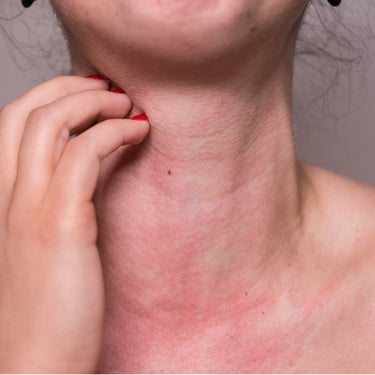
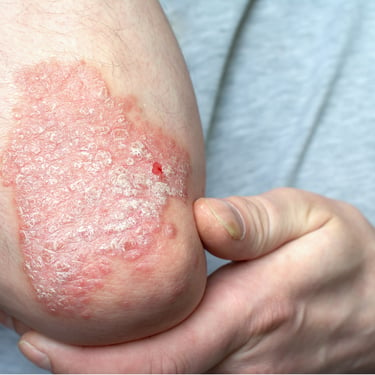
Eczema is a chronic, non-contagious inflammatory skin condition often characterized by dry, red, itchy, and flaky skin.
Acne, commonly known as "pimples," is a skin disease caused by clogged hair follicles and is the most common skin problem among adolescents.
Psoriasis is an autoimmune disease that causes skin cells to grow too quickly, forming thick, silvery, scaly patches.
Hives / Urticaria are an allergic skin condition characterized by the sudden appearance of red, raised, and itchy welts on the skin.
Contact Dermatitis is an inflammatory reaction caused by the skin coming into contact with a certain substance.
Vitiligo is a pigment disorder that causes areas of the skin to develop milky-white patches due to the loss of melanocyte function.
Rosacea is a chronic facial skin condition that primarily affects adults.
Skin Cancer is the uncontrolled growth of abnormal skin cells and is the most common type of cancer in the United States.
Skin diseases are a diverse group of conditions, ranging from minor rashes to severe chronic illnesses. Here are some of the most common ones:
The Role of Hydrogen Gas in Skin Diseases
The skin, being the body's largest organ exposed to the external environment, is susceptible to damage from ultraviolet (UVB) radiation, pollutants, and chemicals. This exposure generates a large number of reactive oxygen species, leading to oxidative stress, which is considered a major cause of skin aging and various skin conditions (such as photodamage, eczema, and psoriasis).
Hydrogen can selectively neutralize harmful hydroxyl radicals (OH⋅), reducing oxidative damage to skin cells and protecting collagen and elastin fibers, thereby slowing down skin aging.
Antioxidant Effect
Promotion of Cell Repair and Regeneration
After myocardial ischemia-reperfusion injury (such as the restoration of blood flow after a heart attack), a large number of myocardial cells die due to apoptosis.
Hydrogen can inhibit the apoptosis of myocardial cells, thereby reducing the area of myocardial infarction and preserving cardiac function, as confirmed in animal models.
Anti-inflammatory Effect
Many skin diseases, such as eczema, psoriasis, and acne, are accompanied by significant inflammatory responses.
Hydrogen can inhibit the production and release of inflammatory cytokines (like TNF−α, IL−6, etc.), which helps to reduce inflammatory symptoms like skin redness and itching.
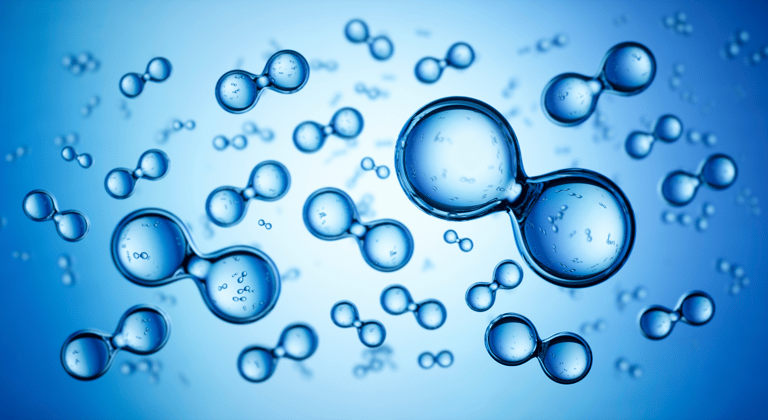

Research into the effects of hydrogen gas on skin diseases is a growing field, primarily focusing on its powerful antioxidant and anti-inflammatory properties. These characteristics show promise for addressing various skin issues linked to oxidative stress and inflammation.
Mechanism of Action
The mechanism of hydrogen's action on the skin is similar to its effect on the nervous system, with its core functions being:
Potential Therapeutic Applications
Photodamage and Skin Aging
Although research has primarily focused on animal models and in vitro experiments, hydrogen has shown potential therapeutic prospects for the following skin conditions:
UV radiation is a major factor contributing to skin photoaging (e.g., wrinkles, pigmentation).
Studies indicate that hydrogen-rich water or hydrogenated saline can reduce skin damage and inflammatory responses caused by UV exposure, suggesting a potential anti-photoaging effect.
Eczema and atopic dermatitis: Hydrogen may help alleviate symptoms like itching, erythema (redness), and dryness through its anti-inflammatory properties.
Psoriasis: In some animal studies, inhaling hydrogen gas or using hydrogenated saline was found to reduce psoriasis-like lesions and inflammatory responses.
Acne: The anti-inflammatory and antioxidant effects of hydrogen are theoretically beneficial for acne treatment.
Inflammatory Skin Diseases
Wound Healing
Hydrogen may accelerate wound healing and reduce scar formation by mitigating inflammation and oxidative stress at the wound site.
Methods of Application
Currently, the primary methods for applying hydrogen to treat skin diseases are:
Hydrogen Gas Inhalation: Breathing a mixture of gases that contains hydrogen.
Topical Application: Using hydrogen-rich water for sprays or soaks.
Drinking Hydrogen-Rich Water: Ingesting it so the hydrogen can be distributed throughout the entire body.
Structure and Barrier Function
Antioxidant and Anti-inflammatory Effects
Specific Amino Acids and Skin Diseases
Synthesis of Collagen and Elastin: The firmness and elasticity of the skin are primarily determined by collagen and elastin. These proteins are composed of specific amino acids like glycine, proline, and lysine. A lack of these amino acids can lead to skin laxity and the formation of wrinkles.
Natural Moisturizing Factors (NMF): The skin's outermost layer, the stratum corneum, contains NMFs, which are a group of substances that help the skin retain moisture. Key components of NMFs are amino acids and their derivatives, such as serine, glycine, and glutamic acid. Their presence helps maintain the skin's barrier function, preventing water loss and the invasion of external irritants.
Synthesis of Glutathione: Glutathione is one of the most important antioxidants in the body, protecting skin cells from oxidative stress damage. It is synthesized from three amino acids: glutamic acid, cysteine, and glycine. Supplementing these amino acids can help enhance the skin's antioxidant capacity, fighting against UV damage and environmental pollution.
Inflammation Relief: Certain amino acids have anti-inflammatory properties. For example, glutamine can promote gut health, and a healthy gut is linked to the relief of skin inflammation (like eczema and acne). Additionally, some amino acids are directly involved in regulating skin immune responses, helping to alleviate the symptoms of inflammatory skin conditions.
Serine and Atopic Dermatitis: Research has found that patients with atopic dermatitis often have low levels of natural moisturizing factors in their skin, and the metabolism of serine, in particular, may be abnormal. Supplementing with serine and its derivatives can help improve the skin barrier function and alleviate the symptoms of atopic dermatitis.
Cystine and UV Damage: Cystine is another important amino acid, serving as a precursor for glutathione and taurine. Supplementing with cystine is believed to enhance the skin's resistance to UV damage, reducing sunburn and photoaging.
Wound Healing and Tissue Repair
Promoting Wound Healing: After skin injury, the body needs a large supply of amino acids to synthesize new tissue for repair. Amino acids such as arginine, proline, and glutamine play a crucial role in this process. They promote collagen synthesis, accelerate wound healing, and reduce scar formation.
Supporting Cell Regeneration: Amino acids are the foundation for cell proliferation and regeneration. When the skin is damaged, providing sufficient amino acids can support the rapid division and repair of skin cells.
Summary
Amino acids influence skin health and disease through multiple pathways: they are the building blocks for skin structure and barrier function; they participate in antioxidant and anti-inflammatory processes, protecting the skin from damage; and they are indispensable raw materials for wound healing and tissue repair. Therefore, obtaining adequate amino acids from diet or supplements is crucial for maintaining healthy skin, especially for those with specific skin conditions.


The Role of Amino Acids in Skin Diseases
Amino acids have a multifaceted role in skin health and disease. They are crucial molecules that make up the structure of the skin, maintain its functions, and participate in its repair processes.
Bio Young Wellness
Look Young, Feel Young, Stay Young
Contact Us
Bio Young Wellness Sdn. Bhd. @ 2024. All rights reserved.
support@bioyoungwellness.com
Quick Links
202101020499(1420799-P)
